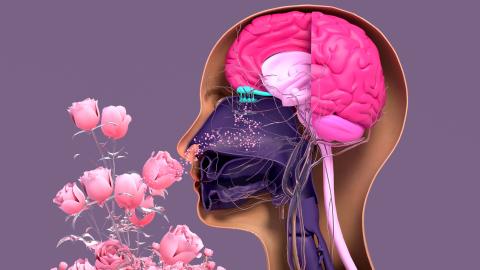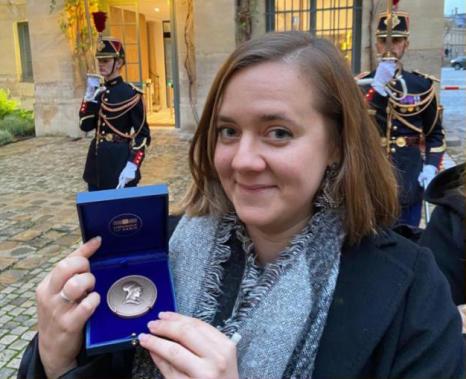
Claire de March: the discovery of the experimental structure of an olfactory receptor
Claire de March is a CNRS researcher at the Institute of Natural Substances Chemistry (ICSN – Univ. Paris-Saclay/National Centre for Scientific Research CNRS), within the Analytical and Structural Chemistry and Biology department and the NMR, Structural Biology and Chemistry team. With her passion for chemistry, she discovered the experimental structure of an olfactory receptor.
Claire de March excelled in chemistry right from secondary school. Ignoring advice to take a certificate of aptitude in beauty, she opted for a technical baccalaureate in chemistry, which she passed with flying colours in 2005 at the Arsonval High School in Saint-Maur-des-Fossés. With her sights set on ISIPCA, a prestigious school specialising in fragrances and flavourings, she enriched her background with a vocational training certificate (BTS), followed by a degree in chemistry at Université de Versailles - Saint-Quentin-en-Yvelines. In 2008, she was accepted into a professional Master's programme and completed a work-study programme with the Bel group, working on the complex aroma of Boursin® cheese. Her research paper focused on the precise measurement of this aroma, i.e. its trigeminal (pungent) characteristics and its temporal evolution. To further her academic career, Claire de March enrolled in a second Master's degree in molecular chemistry at Université Pierre et Marie Curie (now Sorbonne University) in 2011. During this degree, she completed an internship at Université de Nice, where she focused on the aromatic characterisation of table olives, with the aim of distinguishing “appellations d'origine contrôlée” (registered designation of origin) by distinct aromatic profiles.
Computational exploration of olfactory mechanisms
Trained in analytical and organic chemistry, Claire de March turned to computational chemistry during her thesis, carried out from 2012 to 2015 at Université de Nice. "I didn't touch a single lab bench for three years!" She was aiming to model the olfactory process, from the capture of odorant molecules to their processing in the brain, in order to decipher the interaction between molecules and nasal mucus proteins, essential for generating olfactory electrical signals.
She was particularly interested in how odours are interpreted by the olfactory system, with up to 400 types of receptor. Claire de March likens this ability to a "very large piano with 400 keys", where each odorant molecule activates a unique combination of keys to create a distinct olfactory melody, illustrating the combinatorial code of odour perception. "It is estimated that human beings can perceive between 10,000 and one billion different odours, which underlines the scope and complexity of our olfactory capacity."
To overcome the limitations of direct observations, impossible due to the small size and complexity of olfactory receptors, she devoted herself to computer simulation. This method enabled her to closely examine the spatial structure and atomic organisation of receptors, leading to models of unprecedented precision. Using molecular dynamics simulations, which calculate the protein's most probable state every femtosecond (fs or 10-15 s), she produced a sequence revealing the protein's dynamic life on a time scale down to the microsecond (µs or 10-9 s). "This process has provided a new understanding of the dynamic behaviour of these proteins essential to odour perception."
Postdoctoral collaboration in the United States
In January 2016, Claire de March joined the Hiroaki Matsunami laboratory at Duke University, North Carolina, in the Department of Molecular Genetics and Microbiology, and began a post-doctoral fellowship. "I had asked him to help me validate the hypotheses developed during my thesis, and I was delighted to work alongside him, as he has developed several novel methods for measuring the activation of olfactory receptors by odorant molecules." This move marked a mutually beneficial experience: the researcher familiarised herself with cell biology techniques, and learnt how to grow cells and manipulate DNA, while bringing her expertise in computational chemistry to the lab.
OR51E2: the first experimental structure in history
In 2020, thanks to the grant from the NIH Pathway to Independence Award (K99/R00) and in collaboration with the City of Hope National Medical Research Institute in California, Claire de March focused on a key issue: insufficient expression of olfactory receptors in models. "This limitation severely hampered the biochemistry experiments needed to accurately measure the interactions between odorant molecules and olfactory receptors, as well as to obtain a structural understanding of these proteins." Another challenge was the lack of stability of the olfactory receptor in the membrane of cellular models.
To overcome these limitations, consensus theory attracted the attention of both researchers. Claire de March proposed that the amino acid most frequently present in a protein family is probably the one that optimises its function, as opposed to a randomly selected amino acid. They set about creating consensus olfactory receptors, incorporating all the amino acids most commonly observed in olfactory receptors. "These receptors don't exist in the human nose, but they can be compared to ancestral receptors, from which all other receptors evolved. They're ‘engineered’ receptors."
Thanks to this in-depth exploration, they also identified the human olfactory receptor OR51E2. De March then collaborated with researchers at the University of California, San Francisco, to carry out cryo-electron microscopy of this consensus olfactory receptor, which led to the creation of the first experimental structure in history. "It was an incredible experience! Like many researchers, I spent years trying to guess what these olfactory receptors, only discovered in 1991, looked like. I'd never have imagined that I'd be able to do it in my lifetime as a researcher!" This discovery was published in 2023.
Her arrival at the ICSN
Back in France, Claire de March passed the CNRS competitive exam and joined the ICSN as a research fellow in December 2022. "Thanks to experimental knowledge of the static structure of the olfactory receptor, I have the opportunity to open up new avenues for understanding how it works, how it interacts with odorant molecules, its affinities, as well as the impact of consensus, its conservation and stability." While focusing on these aspects, Claire de March hasn't ruled out the prospect of exploring, in the future, the sociological implications of odours and their influence on human behaviour.
Winner of the Irène Joliot-Curie "Young Woman Scientist" award 2023
The prize, awarded in November 2023, recognises not only the scientific excellence of the researcher's work, but also her position as a role model for future generations of female researchers. "Female role models in science are precious but rare. Although Marie Curie is an undeniable source of inspiration, her genius seems unattainable. My ambition is to prove that it is possible to thrive in research through a variety of accessible routes."

